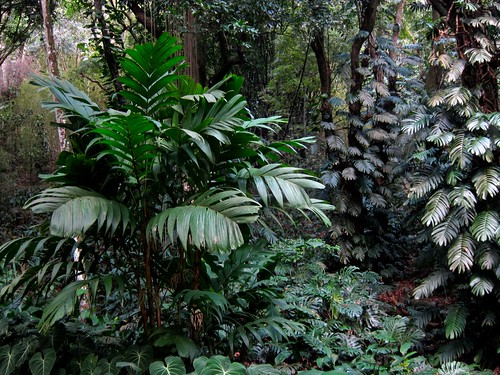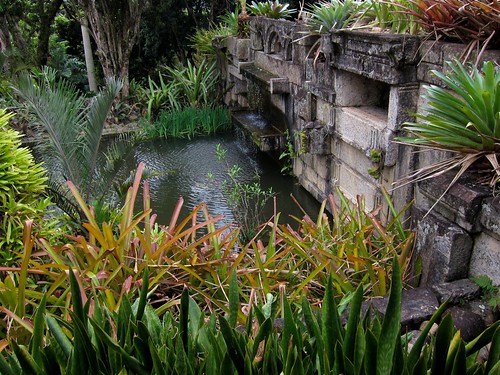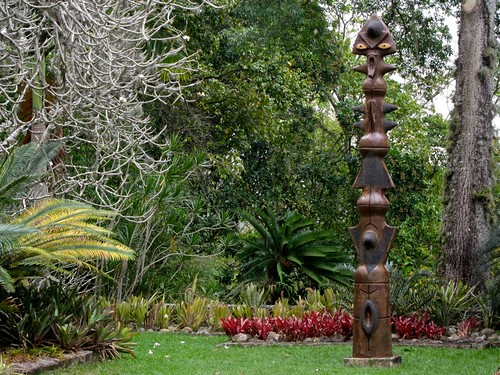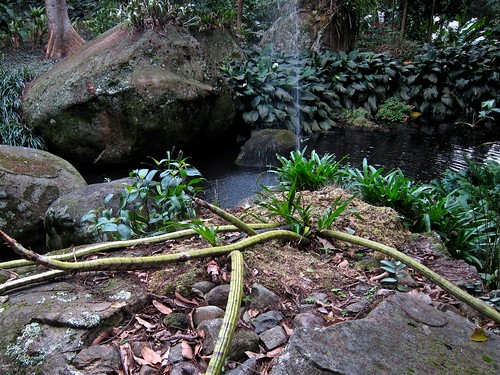ROBERTO BURLE MARX: PAINTING WITH PLANTS
During a recent trip to Rio de Janeiro I got the special treat of visiting the estate and gardens of Roberto Burle Marx who revolutionized landscape architecture by demonstrating that you could literally paint with plants. Using a pallet of some 3,500 varieties (more than the native rainforest diversity) and restoring an abandoned banana plantation he co-created with nature to produce realities of extraordinary beauty. After seeing so many atrocities committed by humans against nature it was totally inspiring to see what a human imagination working with nature can achieve.





Here is an excellent review from the NY Times:
January 21, 2009
A New Look at the Multitalented Man Who Made Tropical Landscaping an Art
By LARRY ROHTER
RIO DE JANEIRO — Brazil teems with jungles, forests and all sorts of exotic plants, flowers and trees. But until the Brazilian landscape architect Roberto Burle Marx came along to tame and shape his country’s exuberant flora, his countrymen had mostly disdained the natural riches that, often literally, flourished in their own backyards.
“Burle Marx created tropical landscaping as we know it today, but in doing so he also did something even greater,” said Lauro Cavalcanti, the curator of an exhibition devoted to the work of Burle Marx that runs through March at the Paço Imperial museum here. “By organizing native plants in accordance with the aesthetic principles of the artistic vanguard, especially Cubism and abstractionism, he created a new and modern grammar for international landscape design.”
Burle Marx was born in 1909, and to mark that centenary the museum set out to show the full extent of his creativity. (The show travels next to São Paulo.) In addition to scale models and drawings of his most celebrated landscape design projects, the exhibition includes nearly 100 of his paintings, as well as drawings, sculptures, tapestries, jewelry, and sets and costumes he designed for theatrical productions. The goal is to show how his work in one field bled into his work in the others.
“He was truly a polymath,” said William Howard Adams, the chief curator of a Burle Marx exhibition presented at the Museum of Modern Art in 1991. “But the thing about him that really stands out is that he regarded landscape design as an equal partner with architecture, not as a backdrop or decoration, and elevated it to that level.”
For his part, Burle Marx always thought of himself first and foremost as a painter, which explains the abundance of canvases in the show. Landscape design, he once wrote, “was merely the method I found to organize and compose my drawing and painting, using less conventional materials.”
It was while studying painting in Germany during the Weimar Republic, as he would later tell it, that Burle Marx realized that the vegetation Brazilians then dismissed as scrub and brush, preferring imported pine trees and gladioli for their gardens, was truly extraordinary. Visiting the Botanical Garden in Berlin, he was startled to find many Brazilian plants in the collection and quickly came to see the untapped artistic potential in their varied shapes, sizes and hues.
“The way he synthesized art and horticulture in three-dimensional design is really quite exceptional,” said Mirka Benes, a landscape historian who teaches at the University of Texas at Austin. “He truly had a painter’s eye, which you could sense in his superb sense of color and form, and he had an understanding of the tenets of Modernism and Dada, having clearly known and studied the work of people like Hans Arp.”
Like Arp, Burle Marx was of German descent on his father’s side and French on his mother’s side. He was born in São Paulo, but moved at a young age to Rio de Janeiro, where one of his neighbors was the Modernist architect Lucio Costa, the future designer of Brasília, who gave Burle Marx his first commissions.
Although Burle Marx had a hand in designing some parts of Brasília, including its hanging gardens, he is especially known among Brazilians for his many ambitious projects here in Rio. “The face of this city bears his imprint,” Mr. Cavalcanti said.
Rio’s largest park, the bayside Aterro do Flamengo, built on reclaimed seafront just southwest of downtown, is an early example of one of Burle Marx’s signature projects. But for sheer sweep, nothing surpasses the sidewalks of Copacabana, with colorful abstract stone mosaics extending unbroken the entire length of that beach. From the upper floors of the buildings that line Avenida Atlantica, Burle Marx appears to have painted a single canvas about three miles long.
“While he enjoyed designing gardens for friends, what gave him the most satisfaction was to work with public spaces,” said Haruyoshi Ono, a Brazilian landscape architect who began working with him in 1965 and today directs the landscaping company that Burle Marx founded in the 1950s. “He used to say the larger and more open a project, the more he liked it, because it could be enjoyed by all social strata.”
Burle Marx’s most elaborate and time-consuming effort, however, may have been an abandoned estate he bought on the outskirts of the city in 1948 and turned into a home, studio and garden complex. Now a national landmark and tourist attraction with more than 3,500 species of plants, it functioned as his workshop, laboratory and office until his death in 1994.
At the peak of his career, Burle Marx was highly esteemed among his peers in the United States. In 1965 the American Institute of Architects awarded him its fine-arts prize, saying that he was “the real creator of the modern garden.”
But unless they traveled to the tropics, American gardeners had little opportunity for direct exposure to his work. Although he designed some gardens in temperate climates, notably for United Nations buildings in France and Austria, “you certainly can’t have a Burle Marx garden in Wisconsin or Vancouver,” Ms. Benes said, “unless you translate his ideas to local plant systems, which looks easy on paper but is not.”
In the United States, Burle Marx’s earliest known project was the Burton Tremaine house in Santa Barbara, Calif., commissioned in 1948. He also designed gardens for the Hilton Hotel in San Juan, P.R., and the Organization of American States headquarters in Washington, and was hired to revamp Biscayne Boulevard in Miami.
Over the last decade he has emerged as “something of a hero” to a new generation of American landscape architects, said Karen Van Lengen, dean of the School of Architecture at the University of Virginia. He is admired not just for his formidable technical skills as an artist, she said, but also for his focus on the scientific side of landscaping and the attention he paid to plant communities and their relationship to the environment.
Burle Marx was almost as much a botanist as a landscape architect, although largely self-taught. More than 50 plant species have been named for him, and he was one of the world’s leading experts on bromeliads, the plant family to which the pineapple belongs. Even in old age he regularly traveled to the Amazon and Southeast Asia to search for unusual and attractive plants that he could cultivate in his home garden and then use in new projects.
“Burle Marx was prescient in his reverence for plants and his stewardship of the whole nursery, for his ability to see the garden both as an aesthetic experiment and also as part of the ecology,” Ms. Van Lengen said. “That’s the challenge for today’s landscape architects, to bring those energies together.
“Burle Marx was already doing that before most people were even thinking about it, so he really stands alone.”
In today's age of concern for sustainability, I was totally inspired to see biodiversity and even recycling achieved so elegantly. One contemporary criticism, though -- he had an aversion to integrating food production (fruits) into his creations.
An interesting aspect of the stonework is that it was all recycled. It seems that during colonial times the Portuguese filled their west-bound ships with stone for ballast. They actually made laws requiring that homes be made of these stones. Once off-loaded the empty ships were filled with commodities for the return voyage. Hundreds of years later Burle Marx found an artistic resource in the dump and resurrected the stone garbage to beauty.
The Burle Marx estate also displays many of his created and collected art pieces and architectural design.
Link to NY Times slideshow.
Link to Google image collection.






No comments:
Post a Comment